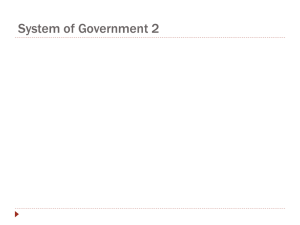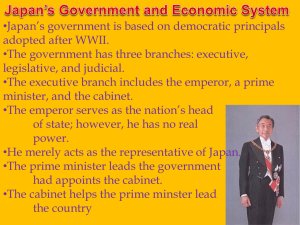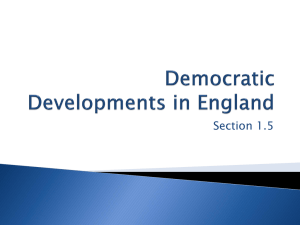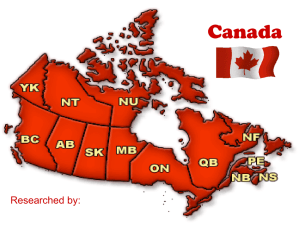Westminster model
advertisement
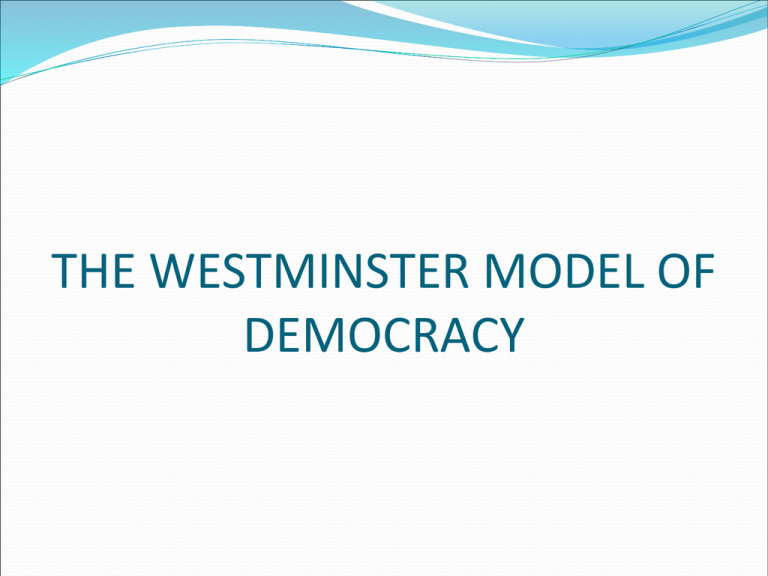
THE WESTMINSTER MODEL OF DEMOCRACY THE WESTMINSTER MODEL Some features of the Westminster model of democracy are: The abolition of the presidential governance and the adoption of the parliamentary governance The UK Parliament is located in the Westminster Palace of London The best example of the Westminster model is the British “democracy” Presidency, Congress and the Supreme Court are the prototype to be adopted everywhere Many aspects of this model can be met in: Canada, Australia, New Zeeland and most of the former British colonies ELEMENTS OF THE WESTMINSTER MODEL 1. 2. 3. 4. 5. 6. 7. 8. 9. 10. Concentrating the executive power in single majority cabinets Prevalence of the cabinet The two-party system The majority disproportional voting system Pluralism of the interest groups Centralized and unitary governance Concentrating the legislative power in a unicameral legislative Constitutional flexibility Lack of the constitutional control The Central Bank controlled by the executive 1. Concentrating the executive power in single majority cabinets The most powerful body of the British governance is the Cabinet, made up of the members of the majority Party in the House of Commons. Coalition governments are rare. The single-party and simple majority government is the best embodiment of the majority governance principle: it exerts the given political power. A large minority is excluded from the governance. 2. Prevalence of the Cabinet The UK has a parliamentary government system, the government being dependent upon the Parliament trust. Theoretically, the House of Commons “controls” the Cabinet. The Government is made up of the leaders of the major party in the House of Commons, the Cabinet being clearly dominated by the Parliament. In a strong governance the cabinets lose their prevalent power. In the 70’s there was significant increase in the Parliament refusals of the main proposals of the cabinets. The Domination of the Cabinet was restored in the 80’s under the control of the conservatory minister Margaret Thatcher. 3. The two-party system The British policy is dominated by two great parties: the Conservatory Party and the Labour Party. Most of the places in the government are taken by these two parties. These two-party systems tend to become one-way systems, namely the programmes and policies of the main parties differ from the social and economic point of view. In this respect, the disagreement about the social-economic policies is what separates the Conservatives and the Laborites. The Laborites are centre-left, while the Conservatives are centreright. Generally, the workers vote for the Laborites, while the middle-class votes for the Conservatives. 4. The majority disproportional voting system The House of Commons is a legislative body with 625-659 members. They are chosen by one eligible place following the plurality way.The candidate with most of the votes wins. This system tends to have disproportional results. History shows that the winning party used to win by “created majority “. The disproportional election system proved disadvantageous, especially for the liberals and the free democrats. So, the tendency is towards proportional representation. The UK rather has a pluralist democracy. 5. The pluralism of the interest groups Concentrating the power in the hands of a majority is the main attribute. The Westminster model creates a competitive and adversative relation for the government against the opposition. The British system is clearly a pluralist one. The social contract concerning salaries and prices was concluded in 1975 between the Labour government, the labour union and the employers – the only exception – which was broken 2 years later. In the 80’s there were confrontations between the Conservative government and the union. Great Britain is accused of not being a corporatist system. 6. Centralized and unitary governance The kingdom is a unitary and centralized state The local executive authority has no powers guaranteed by constitution and is financially dependent on the Central Government The autonomy of Northern Ireland could be eliminated in 1972 by the Parliament by a simple majority decision because from 1921 until 1972 Northern Ireland was led by its own Parliament and cabinet until London imposed its governance There is a tendency towards greater autonomy for Scotland and Wales In 1997 prime-minister Tony Blair announced the end of the “ultra-centralized governmental age” 7. Concentration of the legislative power in a unicameral legislative The majority principle implies that the legislative power be concentrated in a single chamber. Thus, The UK deviates from this principle because its Parliament is made up of two chambers: the House of Commons (a lower house), chosen by people’s vote and the House of Lords (an upper house), made up of nobles. Almost all the legislative power belongs to the House of Commons. In a word, “the Parliament” can mean almost exclusively the House of Commons and the power of the House of Lords can be reduced much more. 8. Constitutional flexibility Great Britain has an “unwritten “ constitution – the making up and powers of the governmental institutions and the citizen rights are defined by a number of fundamental laws like Magna Charta of 1215, the Bill of Rights of 1689 and the Parliament Acts between 1911 and 1949 (principles, practices and legislative acts). The constitution has 2 major implications: 1. It is completely flexible, because it can be changed by the Parliament like any other law 2. The lack of constitutional control 9. Lack of constitutional control There is no constitutional document which makes the Court create the constitution The Parliament is the sovereign authority that can undo any law By entering the European Union, Great Britain became member of the European Convention on Human Rights of 1951 Thus, the Parliament can no longer be considered sovereign Great Britain has the right to control and invalidate any action of the state, including the legislative ones 10. The Central Bank controlled by the executive The independence of the Central Bank is obviously in conflict with the principle of the Westminster model of concentrating the power in the hands of a majority singleparty cabinet Consequently, the Bank of England is under the government control Hardly in 1997 was the Bank of England awarded the power to establish independently the interest rates
